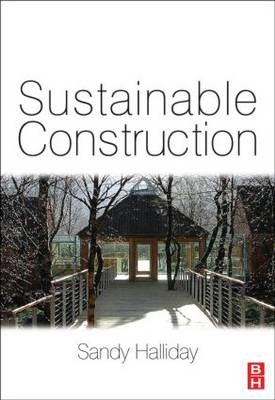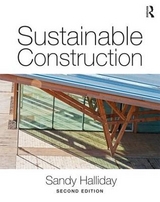
Sustainable Construction
Butterworth-Heinemann Ltd (Verlag)
978-0-7506-6394-6 (ISBN)
- Titel erscheint in neuer Auflage
- Artikel merken
It has taken a very long time for sustainable development to be recognised as a justified restraint on inappropriate development and a primary driver of improving quality of life for all.
For designers, clients and project managers this means we have to create healthy buildings and places which support communities, enhance biodiversity and contribute to reversing unsustainable trends in pollution and resource consumption. It is a very positive agenda.
This groundbreaking book will help all building design, management and cost professionals to understand sustainable design and provide the technical skills needed to implement the most up-to-date concepts. Based on a hugely successful series of workshops for professionals in construction, the book covers the history of ideas, materials, measurement - both cost and benchmarking performance - environmental services, and the building design and delivery process through to post-occupancy evaluation. It covers individual buildings and the urban scale.
Sustainable Construction is a master-class in how to achieve practical, affordable, replicable, sustainable design.
It has something new and often surprising in it for everybody in the construction industry.
For the Architect and Engineer it gives chapter and verse to the basic design issues at all scales and through the whole of the plan of work
For Quantity Surveyors and cost professionals it challenges current conventions with researched case study evidence"
For clients and project managers it outlines the drivers and the justification for a sustainable approach and outlines the legislative framework; and it gives guidance on procurement and project and site management issues
For contractors and developers it contains a wealth of case study material, rooted in practical experience and economic reality.
For teachers and students it will bust myths, liberate thinking and inform design
Chapter 1: Sustainability Drivers
This chapter provides a review of the principle milestones which have brought about the shift in attitudes towards sustainable design of the built environment.
Chapter 2: Policy and Legislation
This chapter aims to highlight the key policy drivers for the creation of more-sustainable construction and the legislative requirements that need to be met.
Chapter 3: Cost Issues
This chapter undertakes a comprehensive review of the cost implications of 'green' building.
Chapter 4: Appraisal Tools and Techniques
A thorough and concise review of methods of obtaining feedback from buildings in use and the history of development of the techniques with a series of case studies largely taken from the PROBE studies.
Chapter 5: Materials Selection
This chapter aims to give the reader a sound and broad grasp of the issues and priorities affecting materials selection in the design of places, buildings, services and objects and a realistic perspective on the range of issues which will affect decision making.
Chapter 6: Low Impact Construction
This chapter looks at recent innovative initiatives to design using very low impact materials such as straw, earth, hemp and timber.
Chapter 7: Heating
This concise document aims to enable the reader to be better equipped to deliver high quality buildings which have a low heating demand and retain a positive affect on health and well being.
Chapter 8: Electrical Installations
This chapter is intended to help designers to develop strategies for low impact electrical services design and to implement them effectively.
Chapter 9: Lighting and Daylighting
This chapter is designed to enable the professional to be better able to make informed decisions about lighting & daylighting design. It directs the reader to contemporary tools and guidance which will assist in implementing best practice.
Chapter 10: Ventilation and Cooling Strategies
Many buildings remain less comfortable and healthy then they might be and consume unnecessary energy for ventilation & cooling. This chapter seeks to highlight the principal issues and sources of guidance.
Chapter 11: Renewable Technologies
Increasingly part of the design pallet and with increasing support from government, renewables are still new to the vast majority of designers and clients. This chapter will give guidance on how to make best use of the available opportunities and how to go about designing and specifying appropriate systems.
Chapter 12: Water and Sewage Management
This chapter considers the flow of water through buildings. It looks at its efficient use, the appropriate treatment of the wastewater discharged and the potential for reuse. It also considers rain falling on and around buildings, the potential for reuse and appropriate discharge.
Chapter 13: Construction Processes
This chapter provides best practice guidance on tender evaluation, site practice, management and handover.
Chapter 14: Urban Ecology
This chapter considers the sustainable design of the built environment of our cities and countryside.
| Erscheint lt. Verlag | 21.12.2007 |
|---|---|
| Verlagsort | Oxford |
| Sprache | englisch |
| Maße | 219 x 276 mm |
| Gewicht | 1406 g |
| Themenwelt | Technik ► Architektur |
| Technik ► Bauwesen | |
| ISBN-10 | 0-7506-6394-4 / 0750663944 |
| ISBN-13 | 978-0-7506-6394-6 / 9780750663946 |
| Zustand | Neuware |
| Haben Sie eine Frage zum Produkt? |
aus dem Bereich



